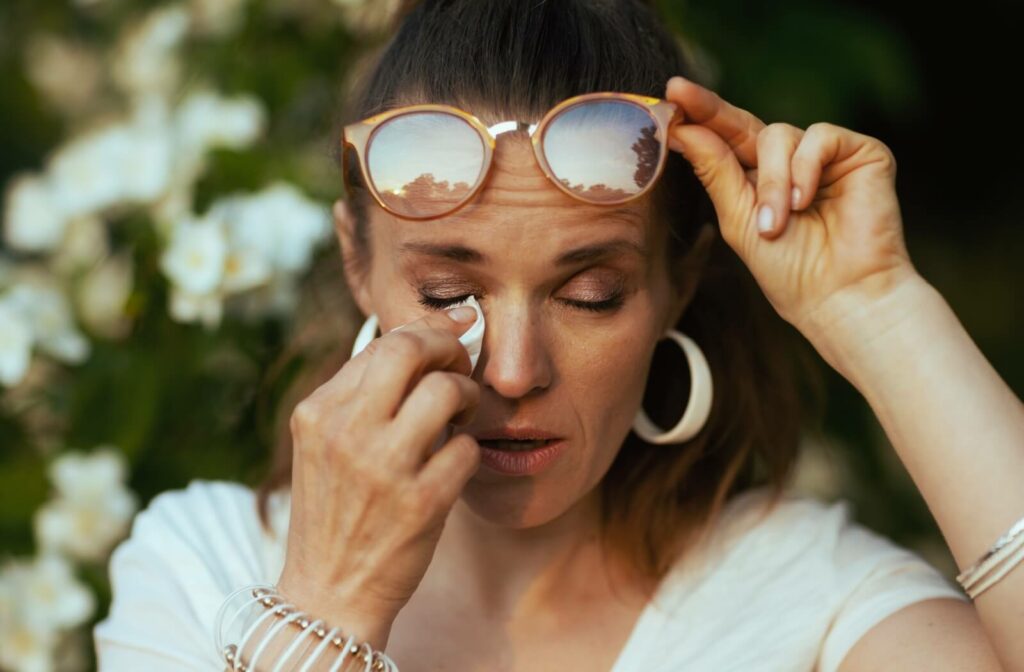Your tears work as a built-in defence system, helping you blink away dust, stay focused during screen time, create a smooth eye surface to support clear vision, or express your emotions. But what happens when your eyes start to water, and it doesn’t feel soothing?
That unexpected stinging or burning sensation can catch you off guard. And while it might seem like a minor annoyance, it’s often your eyes’ way of flagging that something in your environment, eye health, or routine is off balance.
There isn’t just one reason your tears might sting. It’s often linked to a mix of factors. Common causes include environmental irritants, dry eye, blepharitis, allergies, underlying health conditions, or lifestyle habits like screen strain or poor hydration.
Understanding and addressing the underlying cause can help prevent and alleviate eye discomfort.
What Are Tears Made Of?
Tears might seem like simple drops of water, but they’re a complex mix of 3 key layers: water, oil, and mucus. Together, these components help protect your eyes, keep the surface smooth and moist, and provide nutrients to the cornea.
When everything is balanced, tears can effectively support your vision, eye hygiene, and eye comfort. But when that balance is disrupted, whether by outside irritants or internal conditions, you can experience discomfort and an increased risk of eye complications.
Common Reasons Your Tears Might Sting
If your eyes have ever watered only to sting moments later, you’re not alone. Here are some of the most common causes of that sensation, from environmental irritations to eye conditions.
1. Environmental Irritants
Everyday factors like air pollution, smoke, strong fragrances, or cleaning products can irritate your eyes. Windy or dry environments can also disrupt your tear film, making your eyes more vulnerable to stinging and dryness.
Avoiding triggers when possible and using a humidifier indoors may offer relief. Outdoors, wearing protective eyewear—from wide-brimmed sunglasses to sports goggles—can help reduce exposure to wind and airborne particles.
2. Dry Eye Disease
Though it may seem counterintuitive, dry eyes can lead to excessive tearing. Your eyes may produce a rush of watery, low-quality tears in response to dryness.
However, these low-quality tears lack oil and mucus to properly coat the eye’s surface and prevent moisture from evaporating too quickly. Your eyes feel watery, but the eye’s surface isn’t getting the relief or nourishment it needs, resulting in stringing, burning, or grittiness.
Dry eye disease can be linked to reduced tear production, increased evaporation, or underlying inflammation. Common contributors include screen time, age, medications, and hormonal changes.
Adjusting your routine and using lubricating drops can help you manage mild symptoms. You may benefit from prescription eye drops or in-office therapies for severe dry eye.
3. Eye Allergies
If your eyes feel itchy, watery, and burning, especially during allergy season or when exposed to pets, dust, or mould, your symptoms may be allergy-related.
Inflammation from allergic reactions can alter tear composition, causing them to irritate rather than soothe. Other common symptoms include redness, puffiness, and blurred vision.
Management strategies include avoiding known triggers and using antihistamine eye drops, as your healthcare provider recommends.
4. Blepharitis
Blepharitis is a common condition where the edges of the eyelids become inflamed, often due to blocked oil glands. Tears evaporate too quickly without enough oil in your tear film, leading to stinging, a gritty sensation, dry eye, and redness.
Warm compresses and consistent lid hygiene can help in mild cases. For ongoing symptoms, your eye doctor may recommend prescription treatments or an in-office therapy, like BlephEx, to help manage inflammation and bacteria.
5. Lifestyle Habits

Everyday routines and habits can influence tear quality more than you might expect. For example:
- Extended screen time can reduce blinking, which dries out the eye’s surface
- Incomplete makeup removal may leave behind residue that irritates the eyes
- Smoking & second-hand smoke exposure can lead to chronic irritation or vision loss
- Dehydration can impair healthy tear production
Small changes like staying hydrated, taking regular screen breaks, and maintaining good eyelid hygiene can help support more comfortable, stable tears.
6. Conjunctivitis (Pink Eye)
Conjunctivitis (pink eye) can be caused by a viral or bacterial infection, allergies, or chemical exposure. It involves inflammation of the conjunctiva—the clear, transparent tissue covering the white part of the eye and inside the eyelids.
If you have conjunctivitis, you might notice watery, burning, or stinging sensations, along with redness in the white of your eye.
The treatment depends on the cause. For example, if a chemical gets in your eye, thorough flushing is needed to rinse away the irritating substance. Bacterial conjunctivitis can often be managed effectively with antibiotic eye drops or ointments prescribed by your eye doctor.
Because viral and bacterial conjunctivitis can spread easily, it’s crucial to have your eyes examined promptly. While some cases of pink eye might resolve on their own, seeking professional care can often bring you relief more quickly.
7. Health Conditions
Certain medical conditions can affect how your body produces or maintains moisture, including in the eyes.
Rosacea, for instance, can cause eye inflammation (ocular rosacea), which may lead to stinging. Autoimmune disorders such as Sjögren’s disease interfere with the body’s ability to create moisture, often resulting in dry or stinging eyes.
When symptoms persist or are paired with other concerns like light sensitivity or vision changes, speaking with an eye care provider for a more in-depth evaluation is essential.
When to Get It Checked Out
Occasional stinging can be a reaction to wind, dryness, or something in your environment. But it’s worth taking a closer look at if it happens regularly or comes with additional symptoms. Consider booking an eye exam if you notice:
- Frequent stinging or burning
- Ongoing blurry or fluctuating vision
- Eye redness or swelling
- Persistent discomfort that doesn’t improve
Identifying the underlying cause early can help reduce long-term irritation and protect your eye health.
Supporting Your Eyes Starts With Listening to Them
Tears are one of your eyes’ first lines of defence, so when they start to sting, it’s often a sign that your eye health needs attention. Identifying whether the cause is environmental, health-related, or lifestyle-related can empower you to take effective steps toward finding relief.
Book an eye exam with Total Focus Optometry so we can help support your eyes with clear, calm, and personalized care.




